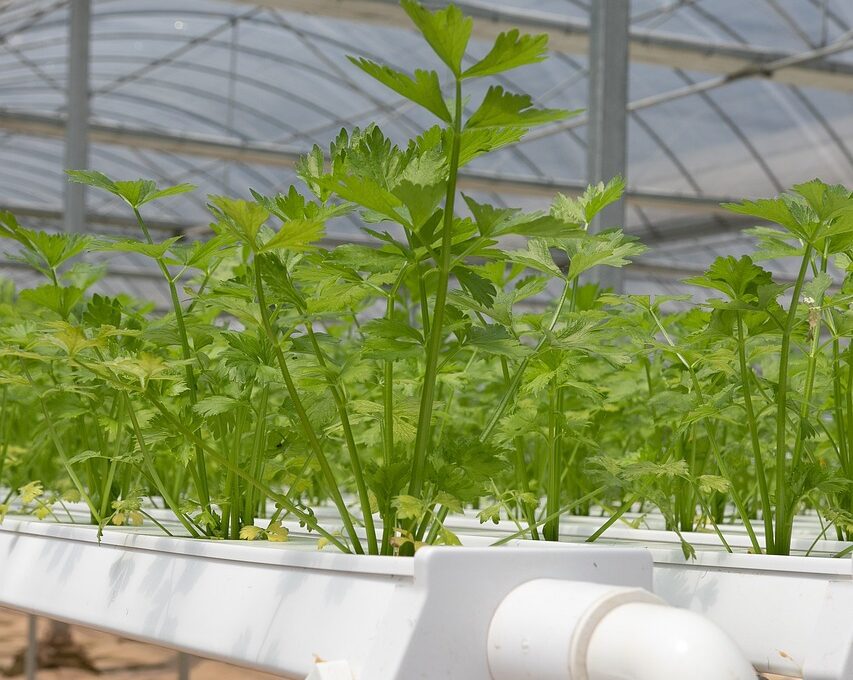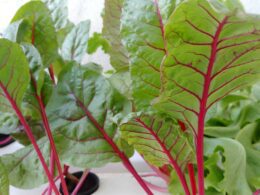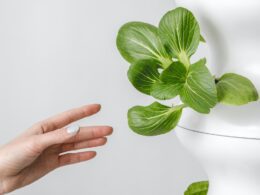Are you noticing some white stuff on your hydroponic plant? Don’t panic, but do pay attention.
This could be a sign of nutrient burn, which is a common issue that can occur in hydroponic gardening. Nutrient burn is a condition caused by an excess of nutrients in the plant’s system, leading to a buildup of salts on the plant’s leaves, resulting in the white stuff you see.
Nutrient burn can be detrimental to your hydroponic plants, causing them to wilt and even die if not addressed promptly. The good news is that nutrient burn is preventable and treatable with the right knowledge and actions.
In this article, we will explore what nutrient burn is, how to prevent it, and what to do if you notice it on your hydroponic plants. We’ll also cover other common hydroponic plant issues and provide tips for maintaining healthy hydroponic plants.
So, let’s dive in and learn how to keep your hydroponic plants thriving!
Understanding Nutrient Burn
You might be experiencing nutrient burn, which can harm your plants if you’re not careful about providing the right nutrients. Understanding the symptoms of nutrient burn is essential to prevent further damage to your plants.
The white stuff on your hydroponic plant could be one of the symptoms of nutrient burn. Identifying the causes of nutrient burn is crucial. One of the leading causes is overfeeding your plants with nutrients. Plants need a balanced amount of nutrients to thrive, and too much of it can cause harm.
Another cause is the pH level of your water. If the pH level is too high or too low, your plants won’t be able to absorb the nutrients correctly, causing nutrient burn. It’s essential to take care of your plants and provide them with the right nutrients.
If you suspect your plant is experiencing nutrient burn, you should take immediate action to prevent further damage. Adjust the pH level of your water and reduce the amount of nutrient you’re adding to your plant’s water. Keep an eye out for any further symptoms and always remember to give your plants the care they need.
Prevention of Nutrient Burn
To prevent nutrient burn, it’s important to be mindful of the amount of nutrients being added to your hydroponic system. Overfeeding your plants can result in the white stuff on your plant, stunting growth, and eventually killing the plant. Here are some tips to help you prevent nutrient burn:
-
Identify symptoms: Look for signs of nutrient burn including yellowing or brown tips on leaves, slow growth, and the white stuff on the plant.
-
Adjust nutrient levels: Start with a lower concentration of nutrients and gradually increase it as the plant grows. Follow the recommended dosage on the nutrient label and keep in mind that different plants have different nutrient requirements.
-
Monitor pH levels: Nutrient uptake is affected by the pH level of the hydroponic system. Keep the pH level between 5.5 and 6.5 for optimal nutrient absorption.
-
Check water quality: The quality of the water used in your hydroponic system can affect nutrient absorption. Use filtered or distilled water to prevent nutrient lockout.
-
Flush the system: If you suspect nutrient burn, flush the system with pH-balanced water to remove excess nutrients.
By following these tips, you can help prevent nutrient burn in your hydroponic system and ensure your plants grow healthy and strong. Remember to always monitor your plants and make adjustments as needed to ensure their success.
Treatment of Nutrient Burn
In this section, you’ll learn how to nurse your nutrient-burned plants back to health with easy-to-follow steps. First and foremost, you need to identify the symptoms of nutrient burn. Look out for brown or yellow patches on the leaves, crispy tips, or leaves that curl downwards. Once you’ve identified the problem, it’s time to take action.
The most essential step in treating nutrient burn is to restore nutrient balance in your hydroponic system. This can be achieved by flushing out the excess nutrients and replacing the nutrient solution with a balanced one. Here’s a table that shows the ideal nutrient balance for different stages of plant growth:
| Nutrient | Vegetative Stage | Flowering Stage | Fruit Stage |
|---|---|---|---|
| Nitrogen | 100 ppm | 50 ppm | 0 ppm |
| Phosphorus | 50 ppm | 100 ppm | 100 ppm |
| Potassium | 100 ppm | 150 ppm | 200 ppm |
Remember to adjust the pH levels as well. A pH level between 5.5 and 6.5 is recommended for most hydroponic plants. Keep monitoring the nutrient levels and pH regularly to make sure your plants are getting the right amount of nutrients.
Lastly, be patient. It takes time for the plants to recover from nutrient burn. During this time, it’s important to provide the right conditions for your plants to thrive. Maintain the proper lighting, temperature, and humidity levels, and keep an eye on any signs of stress. With the right care and attention, your hydroponic plants will soon be back to their healthy and vibrant selves.
Is Overwatering the Cause of the White Stuff on My Hydroponic Plant?
Overwatering often leads to an overwatered lettuce appearance on hydroponic plants. The presence of excessive moisture can cause root rot and oxygen deprivation, resulting in a white, fuzzy substance on the leaves. Maintaining a balanced watering schedule and ensuring proper drainage is crucial to prevent this issue and maintain healthy plants.
Other Common Hydroponic Plant Issues
Let’s explore some other issues that can arise when growing hydroponic plants and how to handle them. One of the most common issues is pest management. Because hydroponic systems create such an ideal environment for plant growth, pests can also thrive. To prevent pests from taking over your hydroponic garden, be sure to regularly check your plants for signs of infestation and take action immediately if you see any. There are many natural and organic ways to control pests, such as introducing beneficial insects or using insecticidal soap.
Another issue that can occur in hydroponic gardens is a pH imbalance. The pH level of your nutrient solution is crucial to the health of your plants, and if it gets too high or too low, it can cause nutrient deficiencies or toxicity. Be sure to regularly test the pH level of your solution and adjust it as needed. You can use pH up or pH down solutions to make adjustments, but be careful not to overdo it.
In addition to pest management and pH imbalances, there are many other issues that can arise when growing hydroponic plants. These include root rot, nutrient deficiencies, and temperature fluctuations. The key to success is to stay vigilant and address any issues as soon as they arise. With a little bit of knowledge and effort, you can enjoy a thriving hydroponic garden with healthy, happy plants.
Tips for Maintaining Healthy Hydroponic Plants
Maintaining healthy hydroponic plants is easy with these helpful tips! By following these simple steps, you can ensure that your plants thrive and produce a bountiful harvest.
-
Keep the pH balance in check: One of the most important factors in hydroponic plant growth is maintaining the correct pH balance. Monitor your water’s pH level regularly and adjust it as needed to ensure that your plants are getting the nutrients they need.
-
Meet lighting requirements: Different plants have different lighting requirements, so be sure to research the specific needs of the plants you’re growing. Make sure they’re getting the right amount of light for optimal growth.
-
Keep the water clean: In hydroponic systems, water is the lifeblood of your plants. Keep the water clean and free of debris or algae buildup by changing it regularly and using a water treatment solution if necessary.
-
Monitor nutrient levels: Plants in hydroponic systems rely on nutrient-rich water for growth. Keep an eye on the nutrient levels in your water and adjust them as needed to ensure your plants are getting everything they need to thrive.
By following these tips, you’ll ensure that your hydroponic plants stay healthy and productive. Remember to monitor pH levels, meet lighting requirements, keep the water clean, and monitor nutrient levels regularly. With a little bit of care and attention, you’ll be rewarded with a beautiful, thriving hydroponic garden.
Frequently Asked Questions
Can nutrient burn affect all types of hydroponic plants?
Are you worried about nutrient burn affecting your hydroponic plants? Don’t worry, it can happen to any type of plant.
To prevent it, make sure to follow the recommended feeding schedule and check the pH levels regularly. Signs of nutrient burn include yellow or brown tips on the leaves, wilting, and stunted growth. If you notice these signs, adjust the nutrient level and pH immediately.
Prevention methods are key to ensuring the health of your hydroponic plants, so stay vigilant and monitor their growth regularly.
How often should I check the nutrient levels in my hydroponic system?
To keep your hydroponic plants healthy and thriving, it’s crucial to monitor the nutrient levels in your system regularly. The benefits of automated nutrient monitoring are clear: it saves you time and hassle while ensuring your plants receive the exact nutrients they need.
pH levels are also essential in nutrient management because they affect the absorption of nutrients by your plants. By keeping pH levels within the optimal range, you can prevent nutrient deficiencies and ensure your plants grow strong and healthy.
Checking your nutrient levels should be done frequently, depending on the size of your system and the types of plants you’re growing. It’s better to check more frequently than not enough to avoid any potential issues. Automated nutrient monitoring systems can make this process even easier and more efficient.
With proper management and monitoring, you can rest assured that your hydroponic plants are receiving the nutrients they need to thrive.
Is it safe to consume hydroponically grown plants that have had nutrient burn?
If you’re consuming hydroponically grown plants, it’s important to consider safety concerns. Nutrient deficiency or nutrient burn can occur in hydroponic systems, leading to an excess of nutrients in the plants. While consuming plants with nutrient burn isn’t necessarily harmful, it’s best to avoid it as it can affect the taste and texture of the plant.
It’s important to regularly check nutrient levels in your hydroponic system to prevent nutrient burn and ensure the safety of your plants. Remember, safety should always be a top priority when consuming any type of plant, whether it’s grown hydroponically or conventionally.
Can nutrient burn occur even if I follow the instructions on the nutrient solution label?
Preventing nutrient burn is crucial to the health of your hydroponic plants, but even if you follow the instructions on the nutrient solution label, nutrient burn can still occur. Signs of nutrient burn include yellowing or browning leaves, stunted growth, and white spots on the leaves.
To prevent nutrient burn, start with a low dose of nutrients and gradually increase as necessary. Remember to check the pH of your solution regularly, as improper pH levels can also contribute to nutrient burn.
Healthy plants are the key to a successful hydroponic system.
How long does it take for a plant to recover from nutrient burn?
If you’ve experienced nutrient burn on your hydroponic plant, you’re probably wondering how long it will take for it to recover. The recovery timeline can vary depending on the severity of the burn and the plant’s ability to bounce back.
In general, it can take anywhere from a few days to a few weeks for the plant to fully recover. To prevent nutrient burn from occurring in the first place, it’s important to carefully follow the instructions on the nutrient solution label and not over-fertilize.
Regularly monitoring your plant’s pH and EC levels can also help prevent nutrient burn. By taking these prevention methods, you can help ensure your hydroponic plants stay healthy and thrive.
Conclusion
So, now you know what that white stuff on your hydroponic plant is – it’s nutrient burn! This occurs when your plant gets too many nutrients, which can cause damage to its roots and leaves.
However, there are ways to prevent and treat nutrient burn. Preventing nutrient burn involves monitoring your plant’s nutrient intake and adjusting as needed, as well as ensuring proper pH levels and avoiding over-fertilization.
If your plant does experience nutrient burn, you can remove affected leaves, adjust your nutrient solution, and flush the roots with clean water. Remember, keeping a close eye on your hydroponic plants and maintaining a healthy growing environment can help prevent various issues and ensure a successful harvest.









